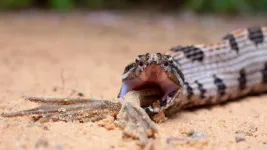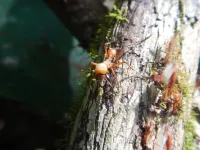(Press-News.org) Tools that allow neuroscientists to record and quantify functional activity within the living brain are in great demand. Traditionally, researchers have used techniques such as functional magnetic resonance imaging, but this method cannot record neural activity with high spatial resolution or in moving subjects. In recent years, a technology called optogenetics has shown considerable success in recording neural activity from animals in real time with single neuron resolution. Optogenetic tools use light to control neurons and record signals in tissues that are genetically modified to express light-sensitive and fluorescent proteins. However, existing technologies for imaging light signals from the brain have drawbacks in their size, imaging speed, or contrast that limit their applications in experimental neuroscience.
A technology called light-sheet fluorescence imaging shows promise for imaging brain activity in 3D with high speed and contrast (overcoming multiple limitations of other imaging technologies). In this technique, a thin sheet of laser light (light-sheet) is directed through a brain tissue region of interest, and fluorescent activity reporters within the brain tissues respond by emitting fluorescence signals that microscopes can detect. Scanning a light sheet in the tissue enables high-speed, high-contrast, volumetric imaging of the brain activity.
Currently, using light-sheet fluorescence brain imaging with nontransparent organisms (like a mouse) is difficult because of the size of the necessary apparatus. To make experiments with nontransparent animals and, in the future, freely moving animals feasible, researchers will first need to miniaturize many of the components.
A key component for the miniaturization is the light-sheet generator itself, which needs to be inserted into the brain and thus must be as small as possible to avoid displacing too much brain tissue. In a new study reported in Neurophotonics, an international team of researchers from the California Institute of Technology (USA), University of Toronto (Canada), University Health Network (Canada), the Max Planck Institute of Microstructure Physics (Germany), and Advanced Micro Foundry (Singapore) developed a miniature light-sheet generator, or a photonic neural probe, that can be implanted into a living animal's brain.
The researchers used nanophotonic technology to create ultrathin silicon-based photonic neural probes that emit multiple addressable thin sheets of light with thicknesses END
Tiny implantable tool for light-sheet imaging of brain activity
Researchers used nanophotonic technology to develop a brain-implantable tool that can aid in the optical imaging of brain activity
2021-04-19
ELSE PRESS RELEASES FROM THIS DATE:
B cell activating factor possible key to hemophilia immune tolerance
2021-04-19
A group of scientists have just made a key discovery that could prevent and eradicate immune responses that lead to treatment failure in about one-third of people with severe hemophilia A.
Hemophilia is the most common severe inherited bleeding disorder in men. The disease affects 1 in 10,000 males worldwide and results from deficiency of blood clotting factor VIII (FVIII). Both children and adults with hemophilia A (80 percent of all hemophilia) receive treatment that involves infusing FVIII protein into the bloodstream. However, about 30 percent ...
Earth's biggest mass extinction took ten times longer on land than in the water
2021-04-19
Our planet's worst mass extinction event happened 252 million years ago when massive volcanic eruptions caused catastrophic climate change. The vast majority of animal species went extinct, and when the dust settled, the planet entered the early days of the Age of Dinosaurs. Scientists are still learning about the patterns of which animals went extinct and which ones survived, and why. In a new study in PNAS, researchers found that while extinctions happened rapidly in the oceans, life on land underwent a longer, more drawn-out period of extinctions.
"People assumed that because the marine extinction happened over a short period of time, life on land should have followed the same pattern, but we found that the marine extinction ...
Archaeological data demand new approaches to biodiversity conservation
2021-04-19
Professor Nicole Boivin, Director of the Department of Archaeology at the Max Planck Institute for the Science of Human History in Jena, Germany, is part of an international initiative to examine the implications of past land use for contemporary conservation efforts.
The multi-disciplinary team, which includes archaeologists, ecologists, anthropologists and conservation managers, has reconstructed ancient population and land use to show that already by 12,000 years ago, humans had re-shaped much of the terrestrial biosphere.
Their data challenge the idea that conservation ...
People have shaped Earth's ecology for at least 12,000 years, mostly sustainably
2021-04-19
New research published today in the Proceedings of the National Academy of Sciences (PNAS) shows that land use by human societies has reshaped ecology across most of Earth's land for at least 12,000 years. The research team, from over ten institutions around the world, revealed that the main cause of the current biodiversity crisis is not human destruction of uninhabited wildlands, but rather the appropriation, colonization, and intensified use of lands previously managed sustainably.
The new data overturn earlier reconstructions of global land use history, some of which indicated that most of Earth's land was uninhabited even as recently as 1500 CE. Further, ...
Clemson researchers find snake venom complexity is driven by prey diet
2021-04-19
Diversity in diet plays a role in the complexity of venom in pit vipers such as rattlesnakes, copperheads and cottonmouths.
But new collaborative research by Clemson University scientists found the number of prey species a snake ate did not drive venom complexity. Rather, it was how far apart the prey species were from each other evolutionarily.
"It's not just diet that drives the variation in venom across snakes. It's the breadth of diet," said Christopher Parkinson, a professor in the College of Science's Department of Biological Sciences. "If a snake eats 20 different species of mammals, its venom will not be very complex. But if it eats a centipede, a frog, a bird and a mammal, it's going to have a highly complex venom because each component of that venom ...
Defensive symbiosis leads to gene loss in bacterial partners
2021-04-19
Antibiotics on the cocoon protect the offspring of beewolves, a group of digger wasps, from detrimental fungi. These protective substances are produced by symbiotic bacteria of the genus Streptomyces, which live in these insects. In a new study in PNAS, researchers from the Max Planck Institute for Chemical Ecology and the University of Mainz, together with an international team, showed that these beneficial bacteria are losing genetic material that is no longer needed. The genome of these bacteria is of great interest for understanding the process of genome erosion and elucidating how the cooperation and the mutual benefit between bacteria and their host insects have evolved over long periods of time (PNAS, doi: 10.1073/pnas.2023047118, ...
Racial violence and the mental health of Black Americans
2021-04-19
Police violence against Black Americans is shamefully common in the United States and devastates communities. For incidents that get widespread media exposure, a collective trauma is felt across the nation, especially for Black individuals. Research supports that experiencing racism even vicariously can harm the mental and physical health of others of the same racial group, yet its effect on a population level is unclear.
A new study analyzed how highly publicized acts of racial violence impacted the mental health of Black Americans in the U.S. The authors identified 49 incidents that occurred between 2013 and 2017, including police killings of Black individuals, hate-crime murders and decisions not to indict or convict the officers involved. The researchers measured ...
Shedding light on the long and the short of plant growth
2021-04-19
What keeps some plants squatting close to the soil while others - even those closely related - reach high for the skies?
New research addressing the architecture and growth habit of plants has provided an answer to this question and may assist in the development of better performing crops.
The way plants grow must sometimes satisfy contradictory needs. Growing close to the ground, decreases the chances of being grazed, but this presents the need to rise rapidly to allow seeds to disperse. This can be observed in dandelions and in Arabidopsis, a model species commonly used to study plant development.
Agriculture has taken advantage of the diversification of growth habit so that ...
Stanford researchers use AI to empower environmental regulators
2021-04-19
Like superheroes capable of seeing through obstacles, environmental regulators may soon wield the power of all-seeing eyes that can identify violators anywhere at any time, according to a new Stanford University-led study. The paper, published the week of April 19 in Proceedings of the National Academy of Sciences (PNAS), demonstrates how artificial intelligence combined with satellite imagery can provide a low-cost, scalable method for locating and monitoring otherwise hard-to-regulate industries.
(WATCH VIDEO: https://www.youtube.com/watch?v=LHvRgKmJOK8)
"Brick kilns have proliferated across Bangladesh to supply the growing economy with construction materials, which makes it really hard for regulators to keep up with new kilns that are constructed," ...
Learning about system stability from ants
2021-04-19
A new type of collective behaviour in ants has been revealed by an international team of scientists, headed by biologist Professor Iain Couzin, co-director of the Cluster of Excellence "Centre for the Advanced Study of Collective Behaviour" at the University of Konstanz and director at the co-located Max Planck Institute of Animal Behavior, and Matthew Lutz, a postdoctoral researcher in Couzin's lab. Their research shows how ants use self-organized architectural structures called "scaffolds" to ensure traffic flow on sloped surfaces. Scaffold formation results from individual sensing and decision-making, ...
LAST 30 PRESS RELEASES:
Boosting the cell’s own cleanup
Movement matters: Light activity led to better survival in diabetes, heart, kidney disease
Method developed to identify best treatment combinations for glioblastoma based on unique cellular targets
Self-guided behavioral app helps children with epilepsy sleep earlier
Higher consumption of food preservatives is associated with an increased risk of type 2 diabetes
NTU Singapore-led team captures first-ever ‘twitch’ of the eye’s night-vision cells as they detect light, paving the way for earlier detection of blindness-causing diseases
Global aviation emissions could be halved through maximising efficiency gains, new study shows
Fewer layovers, better-connected airports, more firm growth
Exposure to natural light improves metabolic health
As we age, immune cells protect the spinal cord
New expert guidance urges caution before surgery for patients with treatment-resistant constipation
Solar hydrogen can now be produced efficiently without the scarce metal platinum
Sleeping in on weekends may help boost teens’ mental health
Study: Teens use cellphones for an hour a day at school
After more than two years of war, Palestinian children are hungry, denied education and “like the living dead”
The untold story of life with Prader-Willi syndrome - according to the siblings who live it
How the parasite that ‘gave up sex’ found more hosts – and why its victory won’t last
When is it time to jump? The boiling frog problem of AI use in physics education
Twitter data reveals partisan divide in understanding why pollen season's getting worse
AI is quick but risky for updating old software
Revolutionizing biosecurity: new multi-omics framework to transform invasive species management
From ancient herb to modern medicine: new review unveils the multi-targeted healing potential of Borago officinalis
Building a global scientific community: Biological Diversity Journal announces dual recruitment of Editorial Board and Youth Editorial Board members
Microbes that break down antibiotics help protect ecosystems under drug pollution
Smart biochar that remembers pollutants offers a new way to clean water and recycle biomass
Rice genes matter more than domestication in shaping plant microbiomes
Ticking time bomb: Some farmers report as many as 70 tick encounters over a 6-month period
Turning garden and crop waste into plastics
Scientists discover ‘platypus galaxies’ in the early universe
Seeing thyroid cancer in a new light: when AI meets label-free imaging in the operating room
[Press-News.org] Tiny implantable tool for light-sheet imaging of brain activityResearchers used nanophotonic technology to develop a brain-implantable tool that can aid in the optical imaging of brain activity







